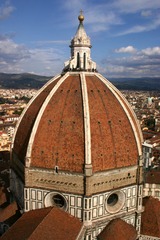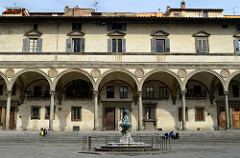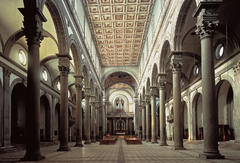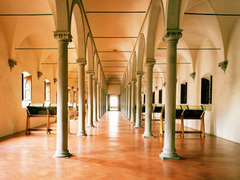
-Filippo Brunelleschi
-1420-1436
-Florence, Italy
-masons worked from movable scaffolding
-“great hoist’ using oxen
-Exterior: white marble ribs divide the dome into eight sections
-structurally the external ribs extend from exterior to interior and provide the basic skeletal structure that is important to the dome’s stability
-dome was built with inner and outer shells. This made the dome lighter and easy to access during construction
-outward thrust is contained by a series of encircling “chains” hidden within the structure
-round windows instead of gothic ones
-harmony, clarity, and simplicity in surface decoration he designed for the clerestory and the drum below the dome
-rectangle panels below the dome show simplicity and order, clear cut proportions and carefully balanced relationships.
-imposed mathematical order for the dome to be constructed exactly half as wide as it is tall
-four exedrae are based off of circular roman temples
-the lantern brings the shapes and forces of the building to a climax
-largest dome constructed since the Pantheon

-Filippo Brunelleschi
-begun 1429
-Florence, Italy
– Brunelleschi’s interest in measure and proportion explains the harmony of the design
-the vaults of the loggia are not ribbed cross-vaults, characteristics of Gothic
-the distance between the centers of the columns is equal to the distance between the center of a column and the back wall of the loggia; creating nearly a square
-smooth column shafts
-uses domical vaults instead
-enameled terra cotta medallions are of swaddling infants who were killed by the order of King Herod

-rebuilt by Filippo Brunelleschi
-c. 1425
-Florence, Italy
-arches on the sides, flat barrel vault in the center
-clerestories with round windows
-arches similar to Foundling hospital
-harmonious alteration of grey and white
-the interior is an exact square, extended on one side by a square altar space flanked by two chambers
-used modules to create a simple system of proportions
-the height of the lower story to the top of the architrave equals both the distance from the architrave to the base of the dome and the distance from there to the base of the lantern
-each story is related to the height of the entire building in the ratio of one to three
-conveys a sense of harmony typical of Renaissance ideals

-Michelozzo di Bartolommeo
-begun 1446
-Florence, Italy
-the entire structure in 70 feet
-pedimented windows on the ground floor
-fortresslike appearance
-rough-cut stones on the ground floor
-rustication of these blocks is imitated from Ancient Roman Monuments
-on the exterior, stringcourses separate the three stories, and the progressive diminution in the height from the lower to the upper story is accompanied by correspondingly smoother surface treatments.
-the rustication of the ground story is replaced on the second by trimmed blocks with deep joints, while the joints between blocks on the third story are almost invisible
-upper story windows are mullioned (divided by colonettes)
-Medici arms and symbols decorate the tops of windows
-large coat of arms on corner
-roof juts out to create a shadow over people who walk by–“Medici are always watching”
-built around a central courtyard

-Michelozzo di Bartolommeo
-1442-1444
-Florence, Italy
-outer halls are groin vaulted while the middle aisle is covered by a barrel-vault.
-effect of perspective recession
-long narrow design with windows on both sides lets in natural sun light.
-slender columns





